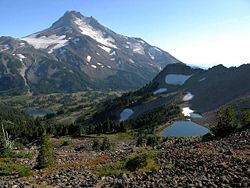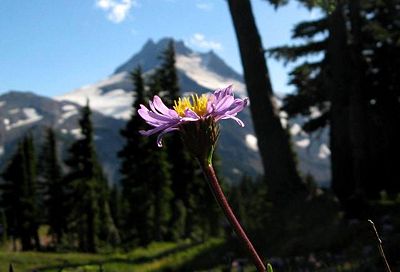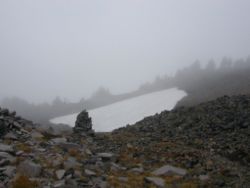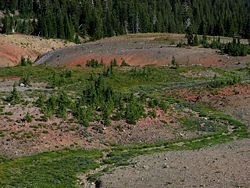Difference between revisions of "Jefferson Park via Park Ridge Hike"
From Oregon Hikers Field Guide
m (added a category: backpackable hikes) |
Justpeachy (Talk | contribs) |
||
| Line 10: | Line 10: | ||
[[Image:ParkRidge6.jpg|thumb|250px|The view from [[Park Ridge]] ''(Steve Hart)'']] | [[Image:ParkRidge6.jpg|thumb|250px|The view from [[Park Ridge]] ''(Steve Hart)'']] | ||
[[Image:ParkRidge7.jpg|thumb|250px|Descending into Jeff Park ''(Steve Hart)'']] | [[Image:ParkRidge7.jpg|thumb|250px|Descending into Jeff Park ''(Steve Hart)'']] | ||
| + | [[Image:Jeffparkflier.jpg|thumb|250px|Forest Service flier showing where you can camp]] | ||
| + | |||
{{Start point|Breitenbush Trailhead}} | {{Start point|Breitenbush Trailhead}} | ||
Revision as of 04:02, 25 August 2014

- Start point: Breitenbush Trailhead
- Ending Point: Jefferson Park
- Trail Log: Trail Log
- Distance: 11.2 miles round trip
- Elevation gain: 2500 feet
- Difficulty: Moderate
- Seasons: July - September
- Family Friendly: No
- Backpackable: Yes
- Crowded: Very
Contents |
Hike Description
The trail (the Pacific Crest Trail, actually) begins at the Breitenbush Trailhead, at an elevation of 5,500 feet. Not surprisingly, snow lingers here well into July. You'll start through small meadows and forests of small trees. At about mile 0.6, you'll notice a small reroute including a new bridge over a rocky channel that's usually dry most of the hiking season. An informal trail leads westward from the older route to Pyramid Butte.
The Crest Trail climbs through a large talus area with views of Pyramid Butte, bright red Ruddy Hill and Olallie Butte, then resumes climbing through huckleberry meadows. The trail crosses a saddle at mile 1.5 and you'll get your first views of Mt Jefferson, even though it's just the highest peak. The trail flattens for a bit, then resumes a well-graded climb into subalpine terrain. The views expand to the west as the trail climbs. There are a couple of small ponds near mile 3, near the edge of timberline.
The land takes on a foreboding look above timberline. There's very little soil here and as a consequence very little plant life. The rocks form large hills resembling castles or monuments. Square, broken pieces of rock form aprons around the bases of the hills. Small seasonal streams drain lingering snowfields deep into September. As you approach the ascent of the ridge, pay close attention to the trail and to the cairns that mark the way. There are a few sections in which it is very easy to lose the trail. As you near the crest of Park Ridge, cross one or multiple (depending on the time of year) snowfields and reclaim the trail, which at this point is very dusty and only occasionally well-defined. Finally, crest Park Ridge and look at the incredible sight in front of you: Mt. Jefferson dominating the view, just 4 or so miles to the south of you. On a nice day (and you really shouldn't do this hike on a rainy day, unless your sole interest is solitude), the top of Park Ridge is a fantastic spot to stop for lunch, and to sit and soak in the impossibly great view of Mt. Jefferson.
To continue to Jefferson Park, follow the obvious trail in front of you downhill for two miles of stupendous scenery to Russell Lake, where you will be greeted by masses of dayhikers, backpackers and professional photographers who hiked one of the other two trails into Jefferson Park. The scenery is stunning. Numerous lakes dot the meadow-filled alpine wonderland while Mt. Jefferson towers over the scene, dominating the skyline. The area is very crowded and some parts have been set aside for restoration. However, you can find solitude if you avoid Scout, Bays, and Russell Lakes (in other words, if you venture off the PCT) and search out one of the many small lakes through the area. It would be very easy to spend several days in the area exploring, and after arriving, you may be wishing you'd brought a backpack, took the week off from work, and/or brought more supplies and took more time off work. It's just that great.
As mentioned, there are two other trails into Jefferson Park: the first, and shortest, leaves from the Whitewater Trailhead east of Detroit and climbs 1800 feet in 5.1 miles to reach Scout and Bays Lakes; the second leaves from the South Breitenbush Trailhead northeast of Detroit and climbs 2800 feet in 6.2 miles through beautiful meadows to meet the PCT near Russell Lake. Both are recommended, though I prefer the South Breitenbush River Trail.
Maps
Fees, Regulations, etc.
- Northwest Forest Pass required at the trailhead.
Trip Reports
- Search Trip Reports for Jefferson Park
Related Discussions / Q&A
- Search Trail Q&A for Jefferson Park
Guidebooks that cover this hike
- 100 Hikes in Northwest Oregon by William Sullivan
- 100 Classic Hikes in Oregon by Douglas Lorain
More Links
- Jefferson Park Ridge - site created by Portland Hiker Splintercat
Contributors
- mattisnotfrench (creator)





